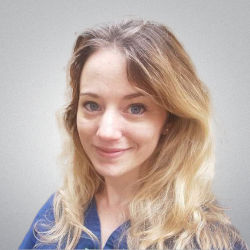
This article was updated on September 19th, 2023
In this article, our seasoned veterinarian Dr. Linda Simon sheds light on the common types of lumps or bumps that may unexpectedly crop up on a dog’s tail. Discover what these lumps could signify and how to address them.
Tail lumps and bumps: top causes
1. The tail gland
Interestingly, the most common ‘tail lump’ an owner will present to me is not a tail lump at all! Indeed, the tail gland (supracaudal or ‘violet’ gland) is a normal part of the dog’s anatomy, but many owners become concerned when they see it for the first time.

Tail glands are flat and can become more bald and prominent with age, especially in males. Their job is to secrete oils. If the gland does swell up, this is known as ‘stud tail.’ The excess sebum produced can make the area greasy and lumpy. We treat this by using medicated washes and some dogs would need antibiotics for any secondary infection. Below is another example of a stud tail:

2. Sebaceous cysts
Sebaceous cysts are usually small lumps that are a blue, grey, or clear color. They tend to have a smooth surface. If the cyst bursts, the contents resemble cottage cheese. Once a dog develops one cyst, they tend to develop more as they get older.


If the cyst is small and not bothering the dog, it is often left alone. However, if it is continually becoming infected or if the vet is unsure what it is, it would be best removed. Learn more about cysts often found on a dog’s tail.
3. Skin tags and warts
Skin tags and warts are incredibly common and many of our furry friends will develop them in their golden years. While the tail is not the typical place for them to occur, they can grow anywhere on the skin. These lesions tend to be small and not well attached to the skin. They can be a range of colors but many are flesh colored.

Skin tags and warts are benign and are only removed if they are bothering the dog or growing rapidly. As most patients who develop them are older, we’d usually only remove them surgically when medically necessary. Learn more about skin tags and warts.
4. Cancers (such as mast cell tumors, sarcomas and sebaceous tumors)
Some tail lumps will be malignant, which is why it is so important to have new growths examined by a vet. As mentioned, tail cancers are very uncommon. I probably see just a handful of cases a year in my busy practice.

These cancers can be any of the same tumors that we see on the skin elsewhere on the body, such as mast cell tumors and soft tissue sarcomas.
With any cancerous lump or lesion, the key is to diagnose and treat it early. The prognosis depends on the type and grade of cancer and whether or not it has already spread. For large and aggressive cancers, tail amputation may be the best way forward.
5. Cornifying epitheliomas
These are benign growths that stick up from the skin, almost like a horn. These funny-looking growths tend to appear on the back or tail of the dog. They have quite a characteristic appearance, so are quite easily diagnosed.

As with other benign skin lesions, we often just leave these growths alone but keep an eye out for any changes or infections. If the lesion is bothering the dog, it can be surgically removed.
When to call the vet, and when to monitor the situation from home
Any new lump should be examined by a vet, particularly if it is bothering the dog or has been present for more than 1-2 weeks. Lumps that are rapidly growing, bleeding, or infected should be examined promptly.
If you’ve just noticed a small lump and your dog is not rubbing or chewing at it, you may decide to monitor it for a week or two, to see if it resolves. Something like an insect bite may be gone within a few days, without any treatment.
Diagnosis can cost $150-$500
When determining what sort of lump or bump we’re dealing with, your vet will first examine the tail and new lesion during a consultation. They’ll then decide if they think it is necessary to sample the lump.
A fine needle aspirate can be done to aspirate cells while the dog is awake, during a routine consult. The cells are sent to a laboratory for analysis and a report is received back within about 5 days.
This procedure costs around $150-$500 depending on the test: a biopsy is when a larger sample of cells is taken, and this requires the dog to be sedated or anesthetized. This procedure is more likely to provide a diagnosis and costs about $300-600. Learn more.
Can a vet diagnose a lump through a video call (instead of an in-office appointment)?
I personally perform online veterinary consults and would feel comfortable diagnosing straightforward warts or cysts on the tail after seeing a photo or video. However, there will be lesions that need to be assessed in person and/or biopsied before we know what they are.
Related posts:
Disclaimer: This website's content is not a substitute for veterinary care. Always consult with your veterinarian for healthcare decisions. Read More.






Be the first to comment